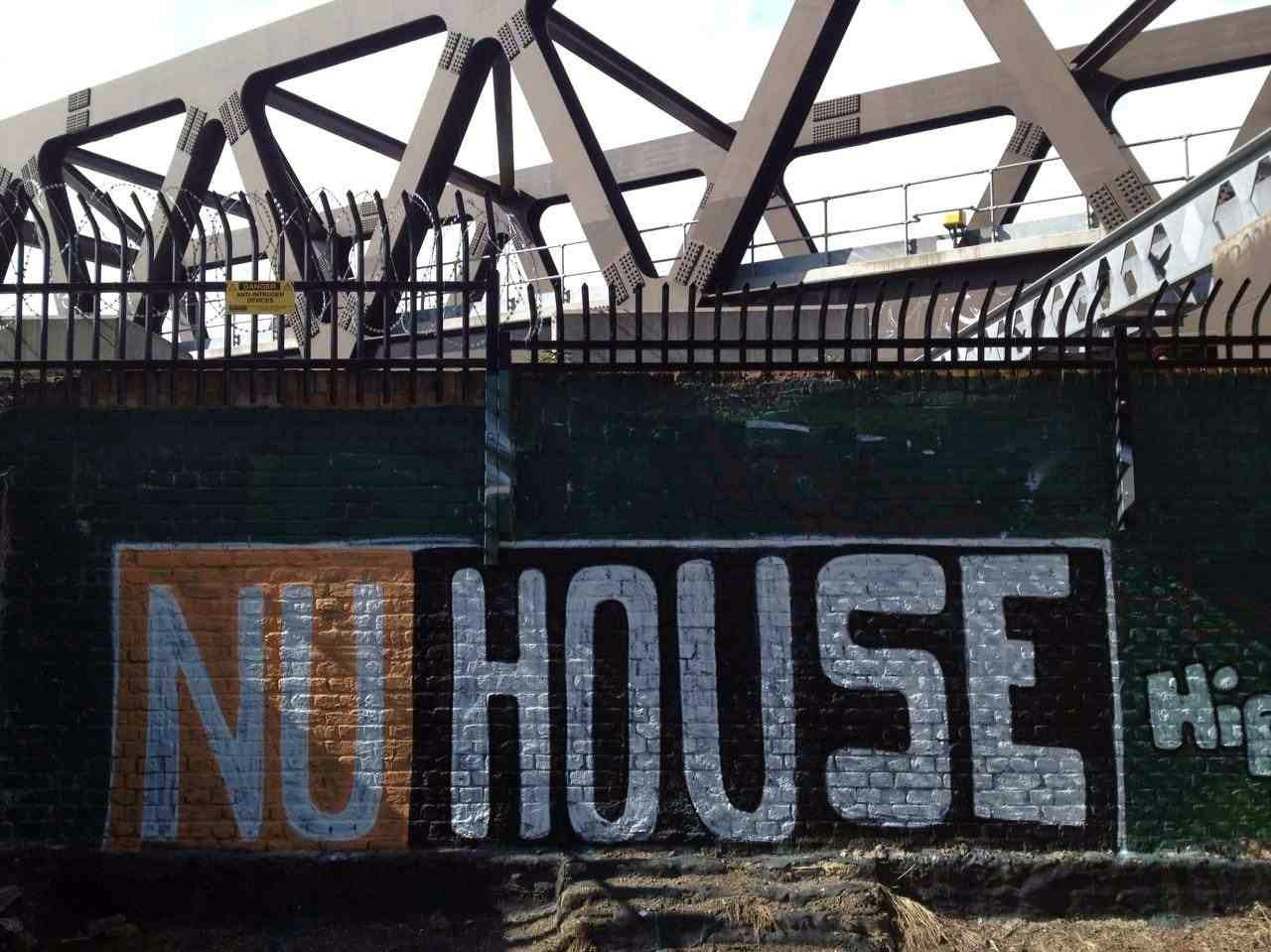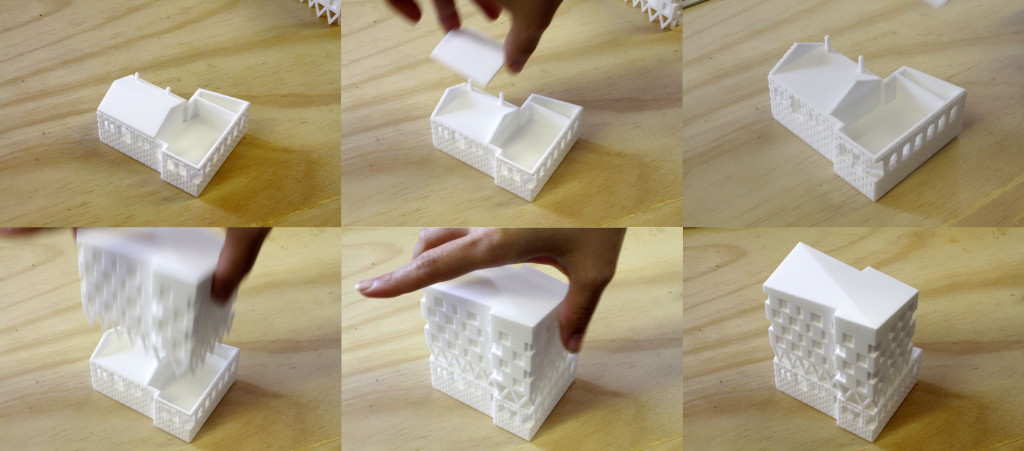127sho_FOYER BY CITYZENKANE
Monumental! Forget mosaics when you can have Cityzen Kane. Next up, Shoreditch Station…
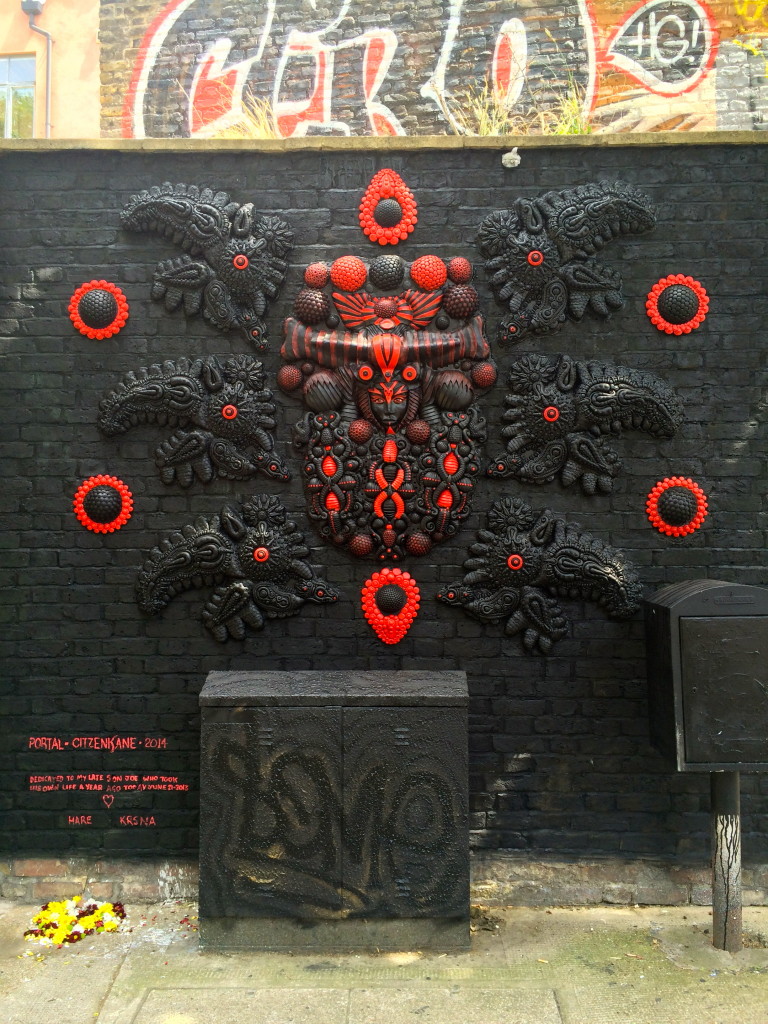


127sho_GHOST TRAIN, GHOST BUILDING: WHICH STATION?
‘Shoreditch’ by Alan Gilbey:
Yes, I remember Shoreditch –
The name, because one afternoon
Confused – I took the wrong train
From Whitechapel. It was late June.
And we trundled and jogged – the truth and I
Through cuttings that cut through – who knows?
Till we stopped at a single platform
And sat there in repose.
Then for one minute, a blackbird sang
Just that – and peace and calm
Till the whinny of a horse arose
From some nearby farm.
The air brakes hissed. Someone cleared his throat
No one left and no one came
On that country station platform
A stone’s throw from Brick Lane.
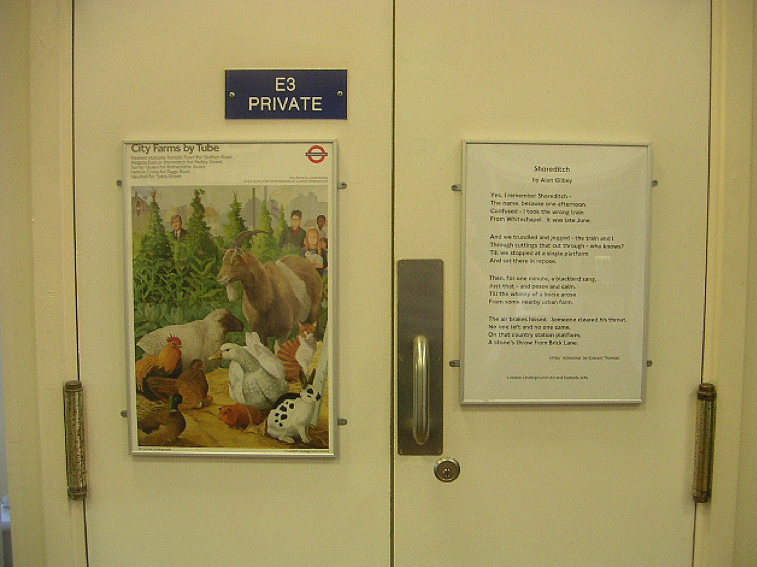 This poem by the local poet Alan Gilbey was hung in the (Pedley Street) Shoreditch Station until the station’s closure in 2006. Today it reads as a lament to a once former Terminus… interestingly there is no mention of the station building itself which was rendered a ‘ghost building’ the day the railway tracks were pulled up, the single platform was buried, the cuttings infilled and the arches demolished. That the poem refers to Spitalfields Farm reinforces our belief in a ‘Sustainable Heritage’: one whereby the dead Station supports the living Farm, the proposed beneficiary of any Section 106 agreement.
This poem by the local poet Alan Gilbey was hung in the (Pedley Street) Shoreditch Station until the station’s closure in 2006. Today it reads as a lament to a once former Terminus… interestingly there is no mention of the station building itself which was rendered a ‘ghost building’ the day the railway tracks were pulled up, the single platform was buried, the cuttings infilled and the arches demolished. That the poem refers to Spitalfields Farm reinforces our belief in a ‘Sustainable Heritage’: one whereby the dead Station supports the living Farm, the proposed beneficiary of any Section 106 agreement.
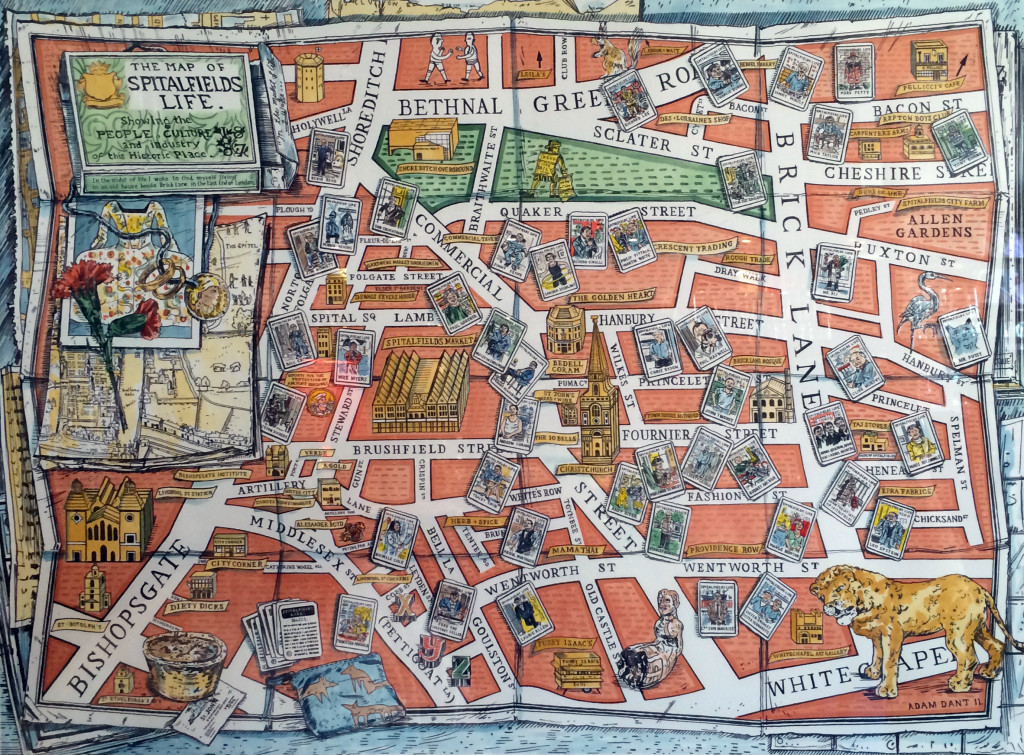 The former (Pedley Street) Shoreditch Station is also conspicuously absent from this 2011 ‘Heritage’ map by The Gentle Author which hangs in the Golden Heart, a local establishment. This map includes notable local points of interest and with respect to Pedley Street indicates Spitalfields Farm and a ukelele shop, the Duke of Uke. In the mapping of ‘Brick Lane’ today by a local historian, Shoreditch Station is indicated yet in its current location on Bethnal Green Road. The former (Pedley Street) Shoreditch Station (as a Terminus) has been bypassed, in both this map and todays London Underground map, as the Conservation Area / city has evolved in the collective consciousness. The Gentle Author recognises that Shoreditch Station has had at least 4 different East London locations over the past 150 years: Liverpool Street, Shoreditch High Street, Pedley Street and today Bethnal Green Road. The UCL Institute of Archeology confirms this in their report: that the former (Pedley Street) Shoreditch Station had literally no foundations – it straddled the now non-existent tracks – and so was always considered, in Heritage terms, a ‘chattel’: a mobile object, building-as-train, that changed location.
The former (Pedley Street) Shoreditch Station is also conspicuously absent from this 2011 ‘Heritage’ map by The Gentle Author which hangs in the Golden Heart, a local establishment. This map includes notable local points of interest and with respect to Pedley Street indicates Spitalfields Farm and a ukelele shop, the Duke of Uke. In the mapping of ‘Brick Lane’ today by a local historian, Shoreditch Station is indicated yet in its current location on Bethnal Green Road. The former (Pedley Street) Shoreditch Station (as a Terminus) has been bypassed, in both this map and todays London Underground map, as the Conservation Area / city has evolved in the collective consciousness. The Gentle Author recognises that Shoreditch Station has had at least 4 different East London locations over the past 150 years: Liverpool Street, Shoreditch High Street, Pedley Street and today Bethnal Green Road. The UCL Institute of Archeology confirms this in their report: that the former (Pedley Street) Shoreditch Station had literally no foundations – it straddled the now non-existent tracks – and so was always considered, in Heritage terms, a ‘chattel’: a mobile object, building-as-train, that changed location.



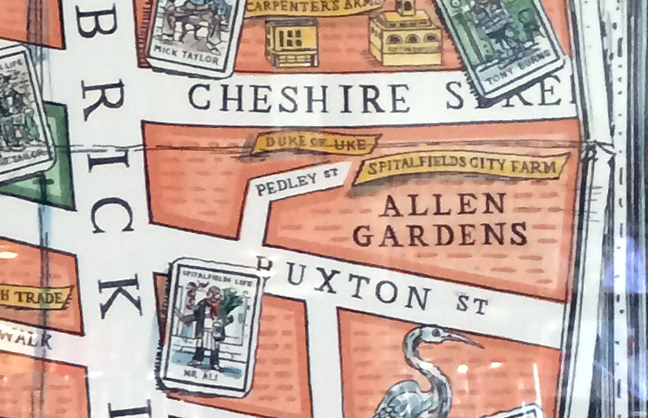
 There are 108 illustrations listed in the book. None feature Shoreditch Station.
The book is 352pages long and mentions “Shoreditch Station” four times on pages 66, 255, 299, 338. All mentions are one sentence references to the Station in terms of locating, e.g p66: “we walked together back down Brick Lane, past Shoreditch Station and a row of shops before turning into a narrow alleyway next to a café, which ended in a iron stairwell”. The contribution of Shoreditch Station to the Conservation Area can be rigorously identified (away from rose-tinted anecdotal evidence) to being one of an urban locator, a sign post. If, since 2006, the heritage setting around the Station has changed dramatically particularly with the installation of the new ELL steel truss bridge which towers over the former Station, then the Station needs to reassert itself as a way finder, a beacon which heralds arrival into Allen Gardens and links the new High Line green park proposed for BishopsGates GoodsYard (which, unlike the Station, was Listed). Context is everything, but if the context changes then Lichtenstein reminds us in her introduction to chapter 12 ‘Disappearances’: “Each person effectively shapes the place by his or her story a thread in thread in the meaning of place and also has to come to terms with the many layers of the story that already exist in a given location.”
Layering is a verticalised strategy for comprehending memory (Underground, Ground, Overground) and is preferred over the ‘train wreck’ that is horizontal juxtaposition. Layering, not juxtaposition, is the architectural strategy. This is why the proposal is a verticalised layering, a palimpsest of the new NOT next to the old but the new UPON the old. Layering reinforces heritage: architecture can be archeology! Furthermore, to really engage in Sustainable Heritage the proposal has to be of a size to socially, economically and ecologically sustain the local Conservation Area neighbourhood that is Allen Gardens and Spitalfields Farm, if not the local ukelele shop…
There are 108 illustrations listed in the book. None feature Shoreditch Station.
The book is 352pages long and mentions “Shoreditch Station” four times on pages 66, 255, 299, 338. All mentions are one sentence references to the Station in terms of locating, e.g p66: “we walked together back down Brick Lane, past Shoreditch Station and a row of shops before turning into a narrow alleyway next to a café, which ended in a iron stairwell”. The contribution of Shoreditch Station to the Conservation Area can be rigorously identified (away from rose-tinted anecdotal evidence) to being one of an urban locator, a sign post. If, since 2006, the heritage setting around the Station has changed dramatically particularly with the installation of the new ELL steel truss bridge which towers over the former Station, then the Station needs to reassert itself as a way finder, a beacon which heralds arrival into Allen Gardens and links the new High Line green park proposed for BishopsGates GoodsYard (which, unlike the Station, was Listed). Context is everything, but if the context changes then Lichtenstein reminds us in her introduction to chapter 12 ‘Disappearances’: “Each person effectively shapes the place by his or her story a thread in thread in the meaning of place and also has to come to terms with the many layers of the story that already exist in a given location.”
Layering is a verticalised strategy for comprehending memory (Underground, Ground, Overground) and is preferred over the ‘train wreck’ that is horizontal juxtaposition. Layering, not juxtaposition, is the architectural strategy. This is why the proposal is a verticalised layering, a palimpsest of the new NOT next to the old but the new UPON the old. Layering reinforces heritage: architecture can be archeology! Furthermore, to really engage in Sustainable Heritage the proposal has to be of a size to socially, economically and ecologically sustain the local Conservation Area neighbourhood that is Allen Gardens and Spitalfields Farm, if not the local ukelele shop…
 Bob Mazzer’s book ‘Underground’ features no imagery of Shoreditch Station.
Bob Mazzer’s book ‘Underground’ features no imagery of Shoreditch Station.
 This poem by the local poet Alan Gilbey was hung in the (Pedley Street) Shoreditch Station until the station’s closure in 2006. Today it reads as a lament to a once former Terminus… interestingly there is no mention of the station building itself which was rendered a ‘ghost building’ the day the railway tracks were pulled up, the single platform was buried, the cuttings infilled and the arches demolished. That the poem refers to Spitalfields Farm reinforces our belief in a ‘Sustainable Heritage’: one whereby the dead Station supports the living Farm, the proposed beneficiary of any Section 106 agreement.
This poem by the local poet Alan Gilbey was hung in the (Pedley Street) Shoreditch Station until the station’s closure in 2006. Today it reads as a lament to a once former Terminus… interestingly there is no mention of the station building itself which was rendered a ‘ghost building’ the day the railway tracks were pulled up, the single platform was buried, the cuttings infilled and the arches demolished. That the poem refers to Spitalfields Farm reinforces our belief in a ‘Sustainable Heritage’: one whereby the dead Station supports the living Farm, the proposed beneficiary of any Section 106 agreement.
 The former (Pedley Street) Shoreditch Station is also conspicuously absent from this 2011 ‘Heritage’ map by The Gentle Author which hangs in the Golden Heart, a local establishment. This map includes notable local points of interest and with respect to Pedley Street indicates Spitalfields Farm and a ukelele shop, the Duke of Uke. In the mapping of ‘Brick Lane’ today by a local historian, Shoreditch Station is indicated yet in its current location on Bethnal Green Road. The former (Pedley Street) Shoreditch Station (as a Terminus) has been bypassed, in both this map and todays London Underground map, as the Conservation Area / city has evolved in the collective consciousness. The Gentle Author recognises that Shoreditch Station has had at least 4 different East London locations over the past 150 years: Liverpool Street, Shoreditch High Street, Pedley Street and today Bethnal Green Road. The UCL Institute of Archeology confirms this in their report: that the former (Pedley Street) Shoreditch Station had literally no foundations – it straddled the now non-existent tracks – and so was always considered, in Heritage terms, a ‘chattel’: a mobile object, building-as-train, that changed location.
The former (Pedley Street) Shoreditch Station is also conspicuously absent from this 2011 ‘Heritage’ map by The Gentle Author which hangs in the Golden Heart, a local establishment. This map includes notable local points of interest and with respect to Pedley Street indicates Spitalfields Farm and a ukelele shop, the Duke of Uke. In the mapping of ‘Brick Lane’ today by a local historian, Shoreditch Station is indicated yet in its current location on Bethnal Green Road. The former (Pedley Street) Shoreditch Station (as a Terminus) has been bypassed, in both this map and todays London Underground map, as the Conservation Area / city has evolved in the collective consciousness. The Gentle Author recognises that Shoreditch Station has had at least 4 different East London locations over the past 150 years: Liverpool Street, Shoreditch High Street, Pedley Street and today Bethnal Green Road. The UCL Institute of Archeology confirms this in their report: that the former (Pedley Street) Shoreditch Station had literally no foundations – it straddled the now non-existent tracks – and so was always considered, in Heritage terms, a ‘chattel’: a mobile object, building-as-train, that changed location.

“The Past being over and done with now falls prey to our invention,” wrote Walter Benjamin. His statement is called upon by Rachel Lichtenstein, who in her book On Brick Lane (fascinating according to The Guardian) recognises that whilst London’s East End has today been reinvented by the creative sector, Lichtenstein’s personal motive tries to preserve what memories she can of its past. So let’s see what Rachel makes of the former (Pedley Street) Shoreditch Station…
 There are 108 illustrations listed in the book. None feature Shoreditch Station.
The book is 352pages long and mentions “Shoreditch Station” four times on pages 66, 255, 299, 338. All mentions are one sentence references to the Station in terms of locating, e.g p66: “we walked together back down Brick Lane, past Shoreditch Station and a row of shops before turning into a narrow alleyway next to a café, which ended in a iron stairwell”. The contribution of Shoreditch Station to the Conservation Area can be rigorously identified (away from rose-tinted anecdotal evidence) to being one of an urban locator, a sign post. If, since 2006, the heritage setting around the Station has changed dramatically particularly with the installation of the new ELL steel truss bridge which towers over the former Station, then the Station needs to reassert itself as a way finder, a beacon which heralds arrival into Allen Gardens and links the new High Line green park proposed for BishopsGates GoodsYard (which, unlike the Station, was Listed). Context is everything, but if the context changes then Lichtenstein reminds us in her introduction to chapter 12 ‘Disappearances’: “Each person effectively shapes the place by his or her story a thread in thread in the meaning of place and also has to come to terms with the many layers of the story that already exist in a given location.”
Layering is a verticalised strategy for comprehending memory (Underground, Ground, Overground) and is preferred over the ‘train wreck’ that is horizontal juxtaposition. Layering, not juxtaposition, is the architectural strategy. This is why the proposal is a verticalised layering, a palimpsest of the new NOT next to the old but the new UPON the old. Layering reinforces heritage: architecture can be archeology! Furthermore, to really engage in Sustainable Heritage the proposal has to be of a size to socially, economically and ecologically sustain the local Conservation Area neighbourhood that is Allen Gardens and Spitalfields Farm, if not the local ukelele shop…
There are 108 illustrations listed in the book. None feature Shoreditch Station.
The book is 352pages long and mentions “Shoreditch Station” four times on pages 66, 255, 299, 338. All mentions are one sentence references to the Station in terms of locating, e.g p66: “we walked together back down Brick Lane, past Shoreditch Station and a row of shops before turning into a narrow alleyway next to a café, which ended in a iron stairwell”. The contribution of Shoreditch Station to the Conservation Area can be rigorously identified (away from rose-tinted anecdotal evidence) to being one of an urban locator, a sign post. If, since 2006, the heritage setting around the Station has changed dramatically particularly with the installation of the new ELL steel truss bridge which towers over the former Station, then the Station needs to reassert itself as a way finder, a beacon which heralds arrival into Allen Gardens and links the new High Line green park proposed for BishopsGates GoodsYard (which, unlike the Station, was Listed). Context is everything, but if the context changes then Lichtenstein reminds us in her introduction to chapter 12 ‘Disappearances’: “Each person effectively shapes the place by his or her story a thread in thread in the meaning of place and also has to come to terms with the many layers of the story that already exist in a given location.”
Layering is a verticalised strategy for comprehending memory (Underground, Ground, Overground) and is preferred over the ‘train wreck’ that is horizontal juxtaposition. Layering, not juxtaposition, is the architectural strategy. This is why the proposal is a verticalised layering, a palimpsest of the new NOT next to the old but the new UPON the old. Layering reinforces heritage: architecture can be archeology! Furthermore, to really engage in Sustainable Heritage the proposal has to be of a size to socially, economically and ecologically sustain the local Conservation Area neighbourhood that is Allen Gardens and Spitalfields Farm, if not the local ukelele shop…
 Bob Mazzer’s book ‘Underground’ features no imagery of Shoreditch Station.
Bob Mazzer’s book ‘Underground’ features no imagery of Shoreditch Station.

127sho_FOLK IN A BOX
Our Shoreditch Station preferred partner Spitalfields Music present Britain’s smallest concert venue: audience capacity is 1. “Folk in a Box is a unique one -on-one music venue and performance space. It is a bespoke wooden box with a little front door for audience members and a little back door for performers. It can be set up anywhere.One audience member is allowed in at a time. The door is closed behind them. They are given one song, performed by one musician. It’s simple, but works like a charm.”
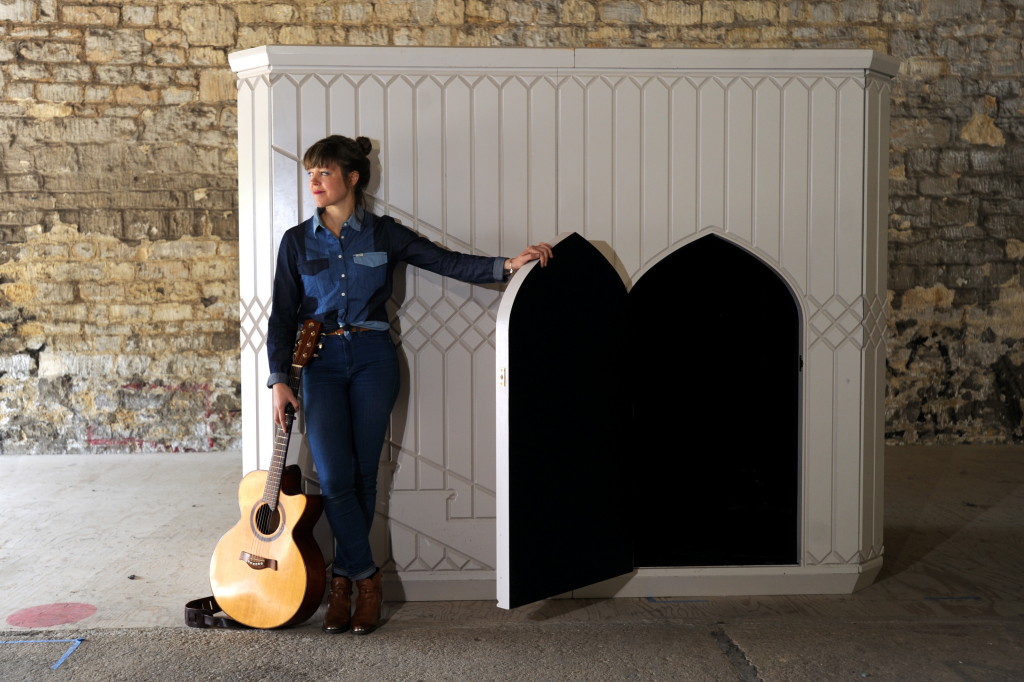 [Vimeo 36453122]
[Vimeo 36453122]
 [Vimeo 36453122]
[Vimeo 36453122]
127sho_STATION RELOCATION PRECEDENT
As a local stakeholder has just pointed out, there was a precedent for the earlier configuration of the Shoreditch Station development which elevated the existing station from the ground to crown the new development. And that is Professor Zhang Lin’s rooftop apartment which rocks. Prof Lin has spent six years shifting rocks and rubble to the roof to create this mountaintop penthouse with its rocky mountain garden, complete with rubble and shrubbery. According to the Daily Mail, local residents have described him as a ‘menace’ after cracks and leaks appeared throughout the apartment block and repute Prof. Lin did not have planning permission for the ‘extension’… For project roles: go to Shoreditch Station Planning Permission Rigmaroles!
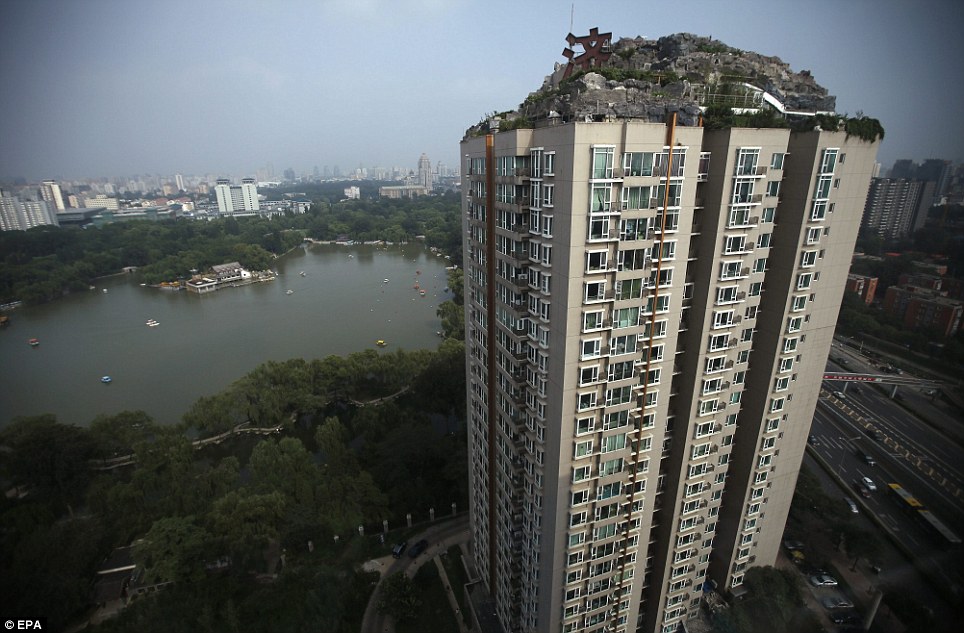
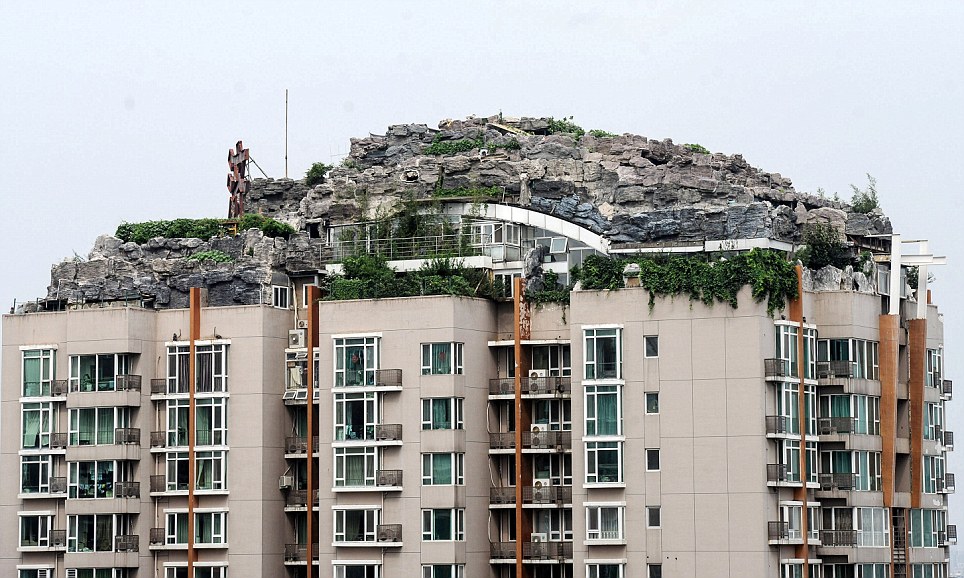



127sho_NU HOUSING NOW!
Local demands for new housing are currently being expressed as politicised graffiti on the building itself… I heard that Nu Office is next. Followed by Nu Mixed Use.
